In Thrive Automator, you are able to create automations that will run whenever an event occurs.
You are able to set up start triggers, that will make the automation begin, and then use filters and actions to make it as complex as you need.
A start trigger is an event and, when it occurs, it will start running the automation. Once you set a start trigger (or multiple ones), you will be able to add actions to the automation, to create different steps that will run in order when the automation starts.
To create complex automations, you will be able to also add filters and conditions (which act as rules – for example: “only execute the automation if this happens“) and/or delays in between actions (to wait a certain amount of time before the next action takes place).
This article will go through the available triggers, filters, actions and delays that can be found in Thrive Automator.
WordPress Account Start Triggers
|
Name |
Description |
|
User logs into account |
This trigger will start the automation whenever a user logs into their account through any form on your site. |
|
User logs out of account |
This trigger will start the automation whenever a user logs out of their account. |
|
Password reset link sent |
This trigger will start the automation whenever the password reset link has been sent to the user. |
|
User resets password |
This trigger starts the automation whenever a user successfully resets their password on your site. |
|
User creates new account |
This trigger starts the automation each time a user creates a new account through any form on your site. |
|
User profile updated |
This trigger will start the automation whenever a user updates their account information on your site. |
|
User leaves comments |
This trigger will be fired whenever a user leaves a comment on the site. |
|
Role is added to a user |
This trigger will be fired whenever a WordPress user role is updated on the site. |
|
Post is published |
The trigger starts whenever a post is published on the website. |
|
Post is updated |
The trigger starts each time a post is updated on the website, based on the criteria set up in the automation. |
Thrive Apprentice Start Triggers
|
Name |
Description |
|
Content is unlocked for a specific user |
This trigger will start the automation when a piece of content is unlocked by another Thrive Automator automation, or by Thrive Apprentice’s Drip Feed feature. If you need a trigger that starts automations when a piece of content is unlocked by a Thrive Apprentice Product, or when content is unlocked for a user manually from the Thrive Apprentice “Customers” section, please see the “User receives access to a product” trigger. |
|
User completes course |
This trigger will fire the automation when the user finishes a course and marks it as completed. |
|
User makes progress in an Apprentice course |
This trigger will start the automation when a user makes a payment and is given access to a Thrive Apprentice product. This will not be fired if a user is manually added to a Thrive Apprentice product. |
|
User enrolls in a bundle (deprecated) |
This trigger will start the automation when a user is added to a specific bundle. Users can be added to a bundle either through purchasing it, or by being manually added through the bundle manager. |
|
User enrolls in a course (deprecated) |
This trigger starts the automation when a user enrolls in a course. It is important to remember here that, depending on the access restrictions of each course, users will be enrolled through different methods:
|
|
User completes all free lessons in a premium course |
This trigger starts the automation if a user completes all the free lessons that are available as part of a premium course. |
|
User completes a lesson in a course |
This trigger will fire the automation when the user marks a specific lesson as completed. The automation will only start if the lesson is published. |
|
User completes a module in a course |
This trigger will fire the automation when the user marks a specific module as completed. The automation will only start if the module is published. |
|
User receives access to a product |
This trigger will start the automation if a user is given access to a Thrive Apprentice product (manually, from the “Customers” section). |
|
User purchases a Thrive Apprentice bundle (deprecated) |
This trigger will start the automation if a user makes a payment and is given access to a Thrive Apprentice course. The automation will not start if a user is manually added to a Thrive Apprentice course. |
|
User purchases a Thrive Apprentice course (deprecated) |
This trigger will start the automation if a user makes a payment and is given access to a Thrive Apprentice bundle. The automation will not start if a user is manually added to a Thrive Apprentice bundle. |
|
User makes a Thrive Apprentice purchase |
This trigger will start an automation when a user makes a payment and is given access to a Thrive Apprentice product. This will not be fired if a user is manually added to a Thrive Apprentice product. |
|
User tries to access a restricted course |
This trigger will start the automation if a user tries to access any restricted lessons or modules in a course. |
|
User starts a course |
This trigger will start the automation the first time a user accesses a lesson or module in a course. This trigger will not start the automation if the user does not have access rights to view the content. |
|
User starts a lesson |
This trigger will start the automation the first time a user views a lesson. This trigger will not start the automation if the user does not have access rights to view the lesson. |
|
User starts a module |
This trigger will start the automation the first time a user views a module overview page. This trigger will not start the automation if the user does not have access rights to view the course content. |
Thrive Leads Start Triggers
|
Form Submit |
This trigger will start the automation when a visitor submits a form from Thrive Leads (such as an opt-in form, a lead shortcode, a ThriveBox, etc.) It is mandatory that the “Email” field is completed in order for the automation to run. |
Thrive Ovation Start Triggers
|
User leaves a testimonial |
This trigger will start the automation when someone submits a testimonial in a Thrive Ovation testimonial capture form. |
Thrive Quiz Builder Start Triggers
|
Name |
Description |
|
User completes quiz |
This trigger will start the automation whenever results are submitted for a quiz. The trigger will not start the automation if the user starts the quiz, but does not complete all the questions. |
|
Form Submit |
This trigger will start the automation when a visitor submits a “Lead Generation” form, placed on an opt-in gate from a quiz, for example. It is mandatory that the “Email” field is completed in order for the automation to run. |
Thrive Ultimatum Start Triggers
|
User triggers Ultimatum evergreen campaign |
This trigger will start the automation when a user triggers an Evergreen campaign from Thrive Ultimatum, by either visiting a Landing Page or entering their details into a “Lead Generation” form. |
Thrive Architect Start Triggers
|
Form Submit |
This trigger will start the automation when a visitor submits a “Lead Generation” form on the website. It is mandatory that the “Email” field is completed in order for the automation to run. |
|
Registration Form Submit |
Use this trigger whenever you want to start the automation with the help of a “Login & Registration Form” element. Use the unique form identifier if you want the automation to start when a particular form is submitted. |
WooCommerce Start Triggers
Note: WooCommerce Start triggers will only work if you have set up WooCommerce on your site.
|
Name |
Description |
|
WooCommerce order completed |
This trigger will start the automation whenever a WooCommerce order is set to complete. |
|
WooCommerce order refunded |
This trigger will start the automation whenever a WooCommerce order is refunded. |
|
WooCommerce order status change |
This trigger will start the automation whenever a WooCommerce order changes its status. |
|
WooCommerce product purchased |
This trigger will start the automation whenever a product is purchased. If two products are purchased as part of the same order, the trigger will fire twice. |
|
WooCommerce product refunded |
This trigger will start the automation whenever a product is refunded. If two products are refunded as part of the same order, the trigger will fire twice. |
Thrive Theme Builder Start Triggers
|
Form Submit |
This trigger will start the automation when a visitor submits a “Lead Generation” form placed on one of your Thrive Theme Builder templates. It is mandatory that the “Email” field is completed in order for the automation to run. |
|
Registration Form Submit |
The automation will start when a “Login & Registration Form” from a Thrive Theme Builder template is filled in and successfully submitted by the visitors. |
Before moving on to the list of available actions and filters, there’s one more thing worth mentioning here.
- Conditions
After you select the start trigger, you can proceed to setting up various conditions for it. In other words, the automation will trigger only if these conditions are met.
The list of available conditions might differ form case to case, depending in the selected trigger:
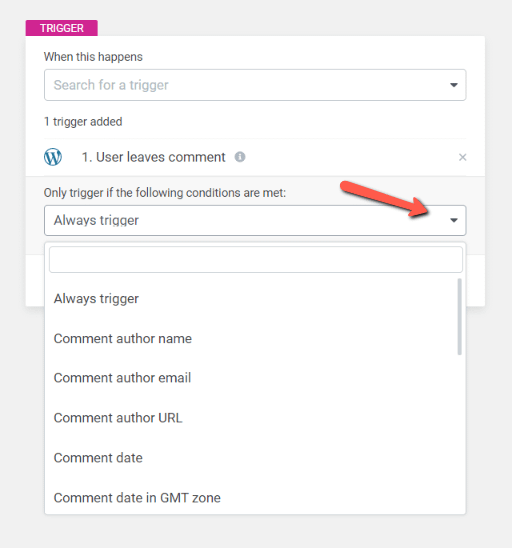
This is not a mandatory step, but it comes in handy if you are trying to create very specific and targeted automations.
Lastly, if you don’t want to use conditions, you can skip this step and add filters, at a later stage in the workflow. We’ve detailed the filtering options further along in this article.
Actions
|
Name |
Description |
|
Enroll user in course (deprecated) |
If this action is added to the automation, the user will be enrolled in the chosen course when the automation flow reaches this step. |
|
Remove user from course (deprecated) |
If this action is added to the automation, the user will be taken out of the chosen course when the automation flow reaches this step. |
|
Grant access to product |
If this action is added to the automation, the user will be given access to a certain product, and you will have to choose which one. |
|
Remove access from product |
If this action is added to the automation, the user will lose their access to a certain product, and you will have to choose which one. |
|
Unlock content for specific user |
If this action is added to the automation, you can choose a specific piece of content to be unlocked for a specific user. |
|
Add user in autoresponder |
If this action is added to the automation, the user will be added to the selected autoresponder when the automation flow reaches this step. |
|
Tag user in autoresponder |
If this action is added to the automation, the user will be assigned a tag in the selected autoresponder when the automation flow reaches this step. |
|
Start an Ultimatum Campaign |
If this action is added to the automation, a Thrive Ultimatum campaign will start when the automation flow reaches this step. |
|
Send Webhook |
You can use this action to send an outgoing webhook to a third-party platform, and thus being able to connect all sorts of tools/apps to Thrive Automator. |
Filters
|
Name |
Description |
|
WordPress user ID |
This filter will allow the automation to continue its flow only if the WordPress user ID is the one that you set up in this field:  This will give you the possibility to only run the automation for specific users. |
|
Specific form |
This filter will allow you to select a specific form from your website, based on the unique identifier code assigned to each form:  |
|
Last logged in |
This filter will allow the automation to continue its flow only if the user has last logged in at the moment/date you have set up here: 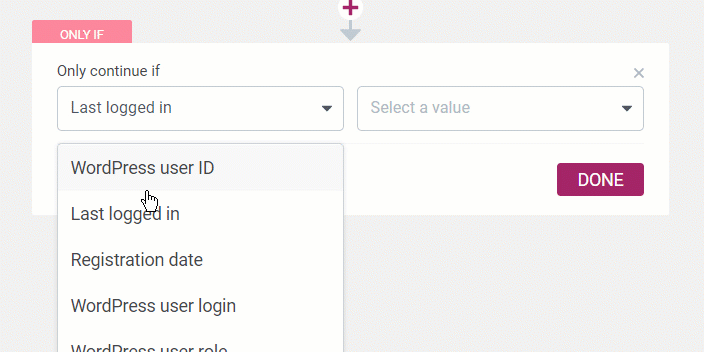 |
|
Registration date |
Similar to the “Last logged in” filter, this one will let you set up the automation in a way that it will run only for the users that have registered at a specific period of time, set by you: 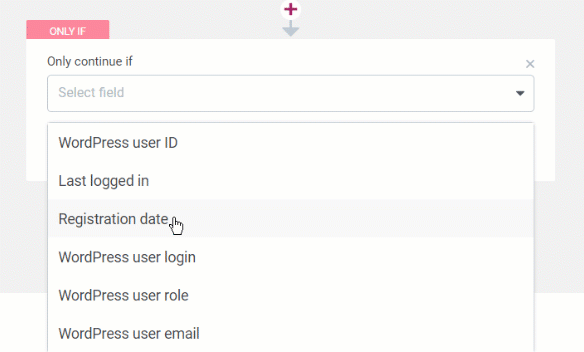 |
|
WordPress username |
This filter will let you set the automation to run for specific users, by adding their username in this field: 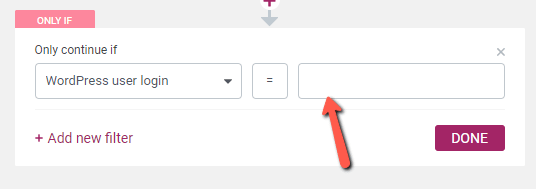 |
|
WordPress user role |
This filter will let you set the automation to run for users that have a specific role on your site, and you can choose which one (you can choose multiple roles here): 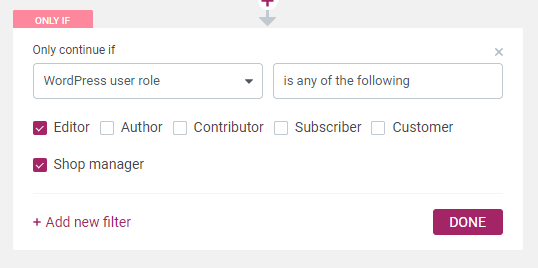 |
|
WordPress user email |
This filter will let you set the automation to run for a specific user, and you will have to enter their email in this field: 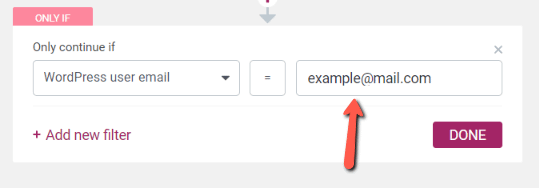 |
Delays
Besides the triggers, actions, and filters, you are also able to customize the automation by adding delays in between its steps:
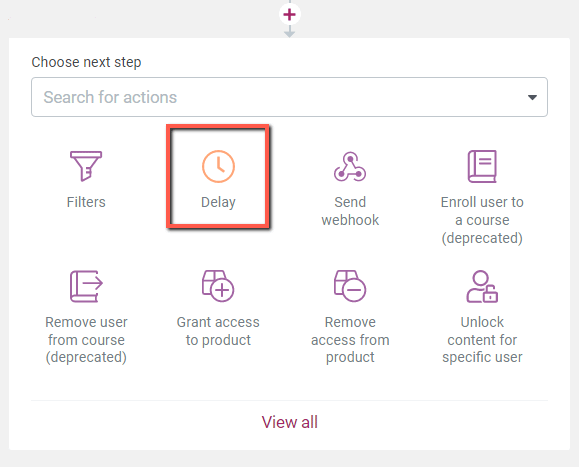
Using the delay will tell the automation to wait for a specific amount of time, set by you until it moves on to the next step:
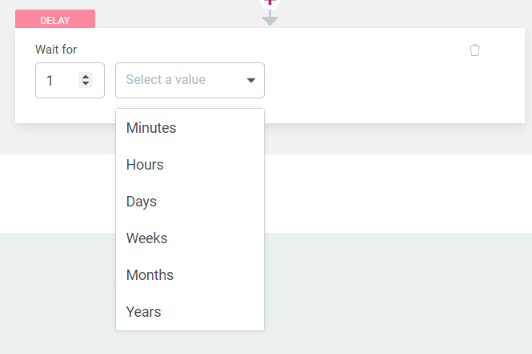
You are able to add delays in between any and as many steps of the automation as you wish.
Important!
- You can choose multiple start triggers – if you do so, at least one of the start trigger events has to occur in order for the automation to start (the start triggers work using an ‘OR’ rule);
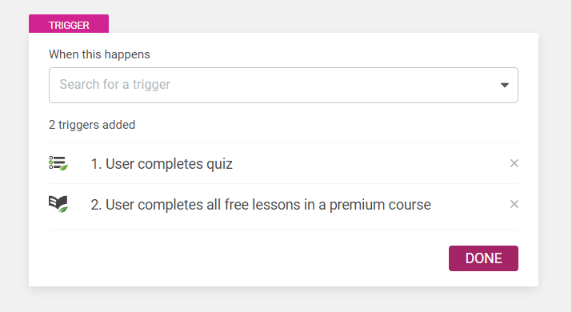
You can add multiple filters in two ways:
- either by adding them using the plus sign in between the automation steps:
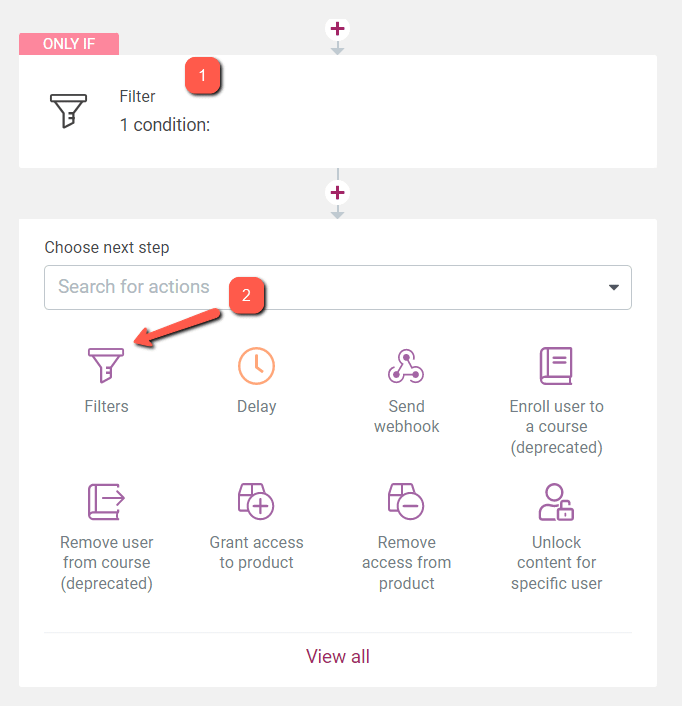
- or by using the “Add new filter” option:
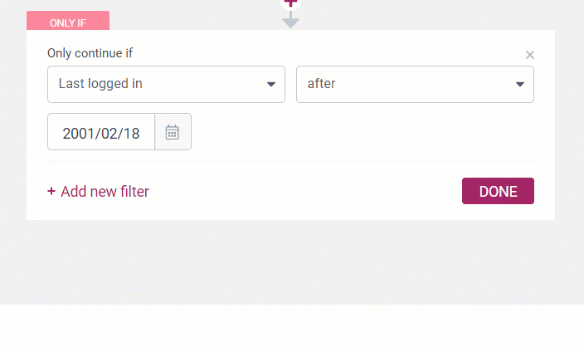
These are the triggers, actions, and filters that can be found in Thrive Automator when setting up a new automation. You can also check out this article, if you want to see which type of data each of the actions and triggers is capturing.
I really hope this article was useful to you. For more information regarding Thrive Automator, be sure to check out these resources:
- or by using the “Add new filter” option: